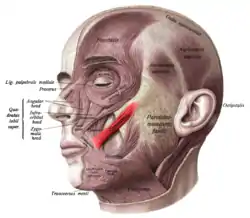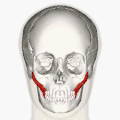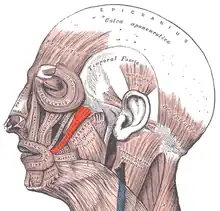Zygomaticus major muscle
The zygomaticus major muscle is a muscle of the face. It arises from either zygomatic arch (cheekbone); it inserts at the corner of the mouth. It is innervated by branches of the facial nerve (cranial nerve VII).
| Zygomaticus major | |
|---|---|
 Muscles of the head, face, and neck. Zygomaticus major shown in red. | |
| Details | |
| Origin | anterior of zygomatic |
| Insertion | modiolus of the mouth |
| Artery | facial artery |
| Nerve | zygomatic and buccal branches of the facial nerve |
| Actions | draws the angle of the mouth upward laterally |
| Identifiers | |
| Latin | musculus zygomaticus major |
| TA98 | A04.1.03.029 |
| TA2 | 2079 |
| FMA | 46810 |
| Anatomical terms of muscle | |
It is a muscle of facial expression which draws the angle of the mouth superiorly and posteriorly to allow one to smile. Bifid zygomaticus major muscle is a notable variant, and may cause cheek dimples.
Structure
Origin
The zygomaticus major muscle originates from the superior margin of the lateral surface of the temporal process of zygomatic bone,[1] just anterior to the zygomaticotemporal suture.[2]
Insertion
It inserts at the corner of the mouth by blending with the levator anguli oris muscle, the orbicularis oris muscle, and the deeper muscular structures.[2]
Nerve supply
The muscle muscle receives motor innervation from the buccal branch and zygomatic branch of the facial nerve (CN VII).[2]
Vasculature
The muscle receives arterial supply from the superior labial artery.[2]
Function
The zygomaticus major muscle raises the upper lip to bare the upper teeth. It additionally deepens and raises the nasolabial furrow. Acting in conjunction with other muslces of facial expression that elevate the lip, it curls the upper lip to produce facial expressions such as smiling, disdain, contempt, or smugnes.[2]
Physiology
The average muscle can contract with a force of 200 g.[4]
Clinical significance
The zygomaticus major muscle may be used in reconstructive surgery to replace lost tissue, such as with injuries to the lips.[5]
Image
 Position of zygomaticus major muscle. Animation.
Position of zygomaticus major muscle. Animation. Muscles of the head, face, and neck. Zygomaticus major shown in red.
Muscles of the head, face, and neck. Zygomaticus major shown in red.
See also
References
- Sarilita, E.; Rynn, C.; Mossey, P.A.; Black, S. (2021-02-01). "Zygomaticus major muscle bony attachment site: a Thiel-embalmed cadaver study". Morphologie. 105 (348): 24–28. doi:10.1016/j.morpho.2020.06.009. ISSN 1286-0115. PMID 32807628. S2CID 221163238.
- Standring, Susan (2020). Gray's Anatomy: The Anatomical Basis of Clinical Practice (42th ed.). New York. p. 624. ISBN 978-0-7020-7707-4. OCLC 1201341621.
{{cite book}}: CS1 maint: location missing publisher (link) - Pessa, Joel E.; Zadoo, Vikram P.; Garza, Peter A.; Adrian, Erle K.; Dewitt, Adriane I.; Garza, Jaime R. (1998). "Double or bifid zygomaticus major muscle: Anatomy, incidence, and clinical correlation". Clinical Anatomy. 11 (5): 310–313. doi:10.1002/(SICI)1098-2353(1998)11:5<310::AID-CA3>3.0.CO;2-T. PMID 9725574. S2CID 39003016.
- Kim, Kyoung-Eun; Oh, Seung Ha; Lee, Shi-Uk; Chung, Sun G. (2009-10-01). "Application of isometric load on a facial muscle – The zygomaticus major". Clinical Biomechanics. 24 (8): 606–612. doi:10.1016/j.clinbiomech.2009.06.008. ISSN 0268-0033. PMID 19631428 – via ScienceDirect.
- Lidhar, T.; Sharma, S.; Ethunandan, M. (2021-01-01). "Split zygomaticus major muscle sling reconstruction for significant lower lip defects". British Journal of Oral and Maxillofacial Surgery. 59 (1): 106–108. doi:10.1016/j.bjoms.2020.06.031. ISSN 0266-4356. PMID 32878716. S2CID 221477454 – via ScienceDirect.